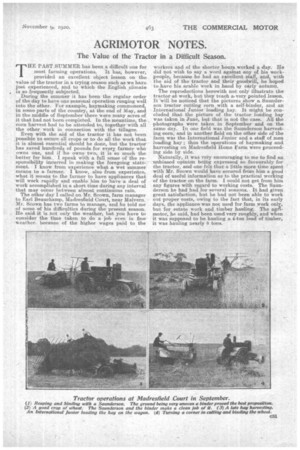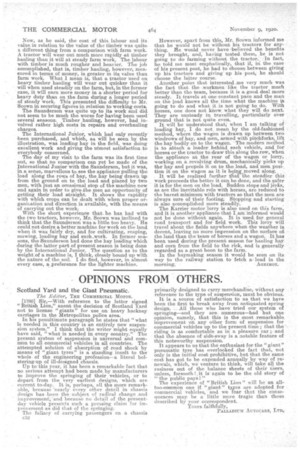• AGRIMOTOR NOTES.
Page 55

Page 56

If you've noticed an error in this article please click here to report it so we can fix it.
The Value of the Tractor in a Difficult Season.
THE PAST SUMMER has. been .a difficult one for most farming operations. It has, however, provided an excellent object lemon on the value of the tractor in a trying season such as we have pet experienced, and to which the English climate
, is so frequently subjected.
During the summer it has been the regular order of the day to have one seasonal operation running well into the other. For example, haymaking commenced, in some parts of the country, at the end of Maty, and in the middle of September there were many acres of it that had not been completed. In the meantime, the corn harvest had to be attended to together with all the other work in connection with the tillages.
Even with the aid of the tractor it has not been possible to secure all crops or to do all the work that it is almost essential should be clone, but the tractor has saved hundreds of pounds for every farmer who owns one, and if he owns two, it is so much the better for him.. I speak with a full sense of the responsibility incurred in making the foregoing statemoot. I know from experience what a wet summer means to a farmer. I know, also from experience, what it means to the farmer to have appliances that will work rapidly and enable him to have a deal of work accomplished in a short time during any interval that may occur between almost continuous rain.
The other day I called on Mr. Scown, farm manager to Earl Beauchamp, Madresfield Court, near Malvern. Mr. Scown has two farms to manage, and he told me of some of his difficulties during the present season. He said it is not only the weather, but you have to consider the time taken to do a job even in fine -weather. because of the higher wages paid to the
workers and of the shorter hours worked a day. He did not wish to say a word against any of his workpeople, because he had an excellent staff, and, with the aid of the tractor and their goodwill, he hoped to have his arable work in hand by early autumn.
he reproductions herewith not only illustrate the tractor at work, but they teach a-very pointed lesson. It will be noticed that the pictures show a Saunderson tractor cutting corn with a self-binder, and an International Junior loading hay. It might be concluded that the picture of the tractor loading hay was taken in June, but that is not the case. All the photographs were taken in September and on the same day. In one field was the Saunderson harvesting corn, and in another field on the other side of the farm was the International Junior and a staff of men loading hay ; thus the operations of haymaking and harvesting on Madresfield Home Farm were proceeding side by side.
Naturally, it was very encouraging to me to find an unbiased opinion being expressed so favourably for the tractor, and one felt that a. little more time spent with Mr. Seown would have secured from him a good deal of useful information as to the practical working of the tractor on the farm. I could not get from him any figures with regard to working costs. The Saunderson he had had for several seasons. It had given great satisfaction, but he had not been able to work out proper costs, owing to the fact that, in its early days, the appliance was not used for farm work only, but for estate work and timber hauling. The agAmotor, he said, had been used very roughly, and when it was supposed to be hauling a 4-ton load of timber, it was hauling nearly 8 tons. Now, as he said, the cost of this labour and its value in relation to the value of the timber was quite a different thing from a comparison with farm work. A tractor will wear out much more rapidly at timber hauling than it will at steady farm work. The labour 'with timber is much rougher and heavier. The job accomplished, that is, timber hauling, however, measured in terms of money, is greater in it value than farm work. What I mean is, that a tractor used on heavy timber hauling will wear out quicker than it will when used steadily on the farm, but, in the former case, it will earn more money in a shorter period for heavy duty than on the farm during a longer period. of steady work. This presented. the difficulty to Mr. 'Scown in securing figures in relation to working costa
The Saunderson was quite up to its work and did not seem to be much the worse for having been used several seasons. Timber hauling, however, had involved rather high costs in repairs and overhauling charges.
The International Junior, which had only recently been purchased, and which, as will be seen by the illustration, was loading hay in the field, was doing excellent work and giving the utmost satisfaction to everybody concerned.
The day of my visit to the farm was its first time out, so that no comparison can yet be made of the International Junior with the Saunders.on, but it was, in a sense, marvellous to see the appliance pulling the load along the rows of hay, the hay being drawn up from the ground on to the load and placed by two men, with just an occasional stop of the machine now and again in order to give .the men an opportunity of getting their load straight. It shows the rapidity -with which crops can be dealt with when proper organiaation and direction is available, with the means of carrying out the work: With the short experience that he has had with the two tractors, however, Mr. Scown was inclined to think that the Saunderson was a little too heavy. He could not desire a better machine for work on the land when it was fairly dry, and for cultivating, reaping, mowing, loading hay and such _work. In former seasons, the Saunderson had done the hay loading which during the latter part of present season is being done by the International Junior. The question as to the weight.of a machine is, I think, closely bound up With the nature of the soil. I do find, however, in almost every case, a preference for the Eglater machine.
However, apart from this Mr. Scown informed me that he would not be without hie tractors for anything. Ile would never have -believed the benefits they brought, and, having tested them, he is not going to do farming without the tractor., In fact, he told me most emphatically, that if, in the case of his present post, he had to choose between giving up his tractors and giving up his post, he should choose the latter course.
Another point that inteeested me very much was the fact that the workmen like the tractor much better than the team, because it is a good deal more steady. It travels at One constant pace and the man on the load knows all the time what the machine going to do and what it is not going to do. With horses, one does not know, what they will do next. They are unsteady in travelling, particularly over ground that is not quite. even. It will be understood that; when I am talking of loading hay, I do not mean by the •old-fashioned method, where the wagon is drawn up between. two windrows of hay, and men, armed with pitchforks, lift the hay bodily on to the wagon. The modern method is to attach a. loader behind each vehicle, and for horses or the tractor to draw this along the row, when the appliance at the rear of the wagon or lorry,' workbag on a revolving drum, mechanically picks up
• the hay and propels it on to the load, and men poei.. tion it on the wagon as it is beingemoved. along. It will be realized further Viet the steadier thia work proceeds the better it can be done, and the safer it is for the men on the Ioad. Sudden stops and jerks, as are the inevitable rule with horses, are reduced to the barest minimum, with tractors so that the men are always tore of their footing. Stopping.and starting is also accomplished more steadily. .
The Karrier motor lorry is also used on this farm, and it is another appliance that Tarn informed would not be done without again. :it is used for general road transport' and for field work. This lorry will travel about the fields anywhere when the weather is decent, leaving no more impression on the surface of. the land than the team of horses and a wagon. It has been used during the present season for hauling hay and corn from the field to the rick, and is generally regarded as a great boon to the farm.
In the haymaking season it would he seen on its way to the railway station to fetch aload. in the morning, AGRIMOT.


























































